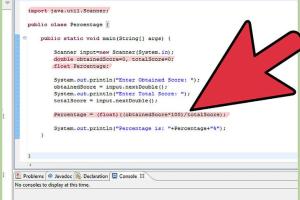Mastering Percentage Calculation in Java: A Comprehensive Guide

-
Quick Links:
- Introduction
- What is Percentage?
- Importance of Percentage in Programming
- Calculating Percentage in Java
- Percentage Calculation Examples
- Step-by-Step Guide to Calculating Percentage
- Real-World Case Studies
- Expert Insights on Percentage Calculations
- Common Mistakes When Calculating Percentages in Java
- FAQs
Introduction
Java is a versatile programming language widely used for various applications, from web development to mobile apps. One common task in programming is calculating percentages. This article will guide you through the process of calculating percentages in Java, complete with examples, case studies, and expert insights.
What is Percentage?
A percentage is a dimensionless number used to describe a proportion or a fraction of a whole, expressed as a fraction of 100. For instance, if you score 80 out of 100 in an exam, your score can be represented as 80%. Understanding percentages is crucial in various fields, including finance, statistics, and data analysis.
Importance of Percentage in Programming
Calculating percentages is critical in programming for several reasons:
- Data analysis and reporting
- Financial calculations
- Performance metrics
- Resource allocation
Calculating Percentage in Java
To calculate a percentage in Java, you generally use the formula:
percentage = (part / total) * 100;Where part is the portion of the total, and total is the whole quantity.
Percentage Calculation Examples
Example 1: Simple Percentage Calculation
Let's create a simple Java program to calculate the percentage of a student’s score.
public class PercentageCalculator {
public static void main(String[] args) {
double score = 80;
double total = 100;
double percentage = (score / total) * 100;
System.out.println("Percentage: " + percentage + "%");
}
}Example 2: Percentage of Multiple Subjects
Now, consider a scenario where a student has scores in multiple subjects. Here's how you can calculate the overall percentage:
public class OverallPercentageCalculator {
public static void main(String[] args) {
double mathScore = 85;
double scienceScore = 90;
double englishScore = 80;
double totalSubjects = 3;
double totalScore = mathScore + scienceScore + englishScore;
double percentage = (totalScore / (totalSubjects * 100)) * 100;
System.out.println("Overall Percentage: " + percentage + "%");
}
}Step-by-Step Guide to Calculating Percentage
Follow these steps to calculate percentages in Java:
- Identify the part and the total values.
- Apply the percentage formula.
- Handle edge cases (like division by zero).
- Print or return the result.
Real-World Case Studies
Case Study 1: E-commerce Sales Analysis
In an e-commerce platform, calculating the percentage of sales growth is vital for business strategy. Consider an online store that had sales of $10,000 last year and $15,000 this year:
public class SalesGrowthCalculator {
public static void main(String[] args) {
double lastYearSales = 10000;
double thisYearSales = 15000;
double growth = ((thisYearSales - lastYearSales) / lastYearSales) * 100;
System.out.println("Sales Growth Percentage: " + growth + "%");
}
}Case Study 2: Performance Evaluation
Companies can use percentage calculations to evaluate employee performance based on targets achieved. For example, if an employee achieved 75 out of a target of 100 sales:
public class EmployeePerformance {
public static void main(String[] args) {
double achieved = 75;
double target = 100;
double performancePercentage = (achieved / target) * 100;
System.out.println("Performance Percentage: " + performancePercentage + "%");
}
}Expert Insights on Percentage Calculations
Experts recommend understanding the context of percentage calculations to avoid misinterpretations. For example, a sales increase of 50% does not always mean doubling sales; it depends on the base value.
Common Mistakes When Calculating Percentages in Java
- Forgetting to handle division by zero.
- Not converting integers to double before division.
- Misunderstanding the percentage formula.
FAQs
1. How do I avoid division by zero when calculating percentages?
Always check if the total is zero before performing the calculation.
2. What data types should I use for percentage calculations in Java?
Use the double data type to handle decimal values accurately.
3. Can I calculate percentage using integer values?
Yes, but ensure to cast to double for accurate results.
4. How can I calculate percentage change in Java?
Use the formula: (newValue - oldValue) / oldValue * 100.
5. Are there libraries available for advanced percentage calculations in Java?
Yes, libraries like Apache Commons Math offer advanced mathematical functions.
6. How can I format percentage output in Java?
Use DecimalFormat to format the output as a percentage.
7. What's the difference between percentage and percentage points?
Percentage points refer to the difference between two percentages, while percentage represents a fraction of a whole.
8. Can I calculate percentages for large datasets in Java?
Yes, Java is efficient in handling large datasets, just be mindful of memory management.
9. Is there a way to visualize percentage data in Java?
Yes, libraries like JFreeChart can be used for visualizing percentage data.
10. How do I ensure accuracy in percentage calculations?
Always use appropriate data types and check for potential errors in calculations.
Random Reads
- How to become an amazon affiliate
- How to install tempered glass screen protector
- Mastering google voice texting
- How to save on new super mario bros ds
- 7 ways to transfer files to ipad
- Summon herobrine minecraft pe mod
- How to use httrack in 9 simple steps
- How to use gimp
- How to use google calculator
- How to make iphone flash when receiving text